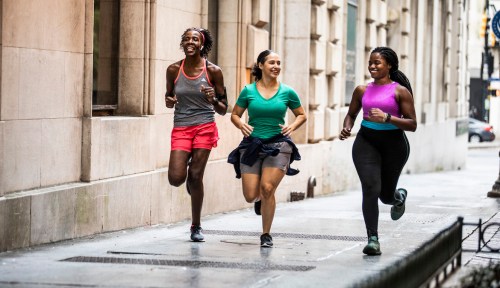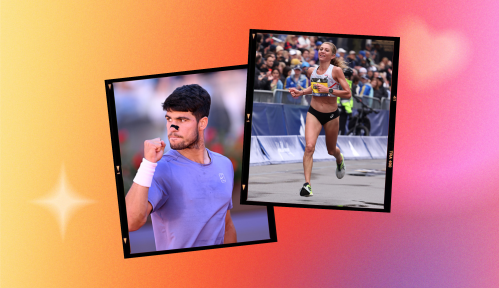The Difference Between Jogging and Running—and Why It Doesn’t Actually Matter
Learn why the jogging vs. running distinction is disappearing. People are embracing the term "jogger" as the sport opens up to more people.

After you lace up your shoes, what do you tell your friends or family you’re about to go do? Do you say you’re going for a jog or a run—and is there actually a difference between the two?
Experts in This Article
UESCA-certified ultra-running coach
registered dietitian, exercise physiologist, and owner of JM Wellness
an ACSM-certified exercise physiologist at Treadmill Review Guru
According to Jason Machowsky, RD, CSSD, CEP, CSCS, registered dietitian, exercise physiologist, and owner of JM Wellness, researchers have yet to define them as different activities, often using them interchangeably. “There is no hard research that says, ‘here’s the cutoff, you must be going faster than X-miles per hour to be running versus jogging,’” he says.
However, among run clubs and veteran athletes, the difference between the two is colloquial. “Within running communities, the distinction between jogging and running can be a nuanced social marker,” says Brian Passenti, UESCA-certified ultra-running coach. “Jogging can be seen as a less intimidating, more accessible form of exercise, [whereas] running is often associated with a more serious, competitive mindset.”
The differences between jogging and running
Running and jogging are often perceived as different modes of the same aerobic exercise. But why? As Kaleigh Ray, CEP, a running biomechanist and ACSM-certified exercise physiologist at Treadmill Review Guru, points out, this distinction may stem from the coaching level.
Jogging often means low effort—but there’s a catch
“When coaching athletes, I use the word ‘jogging’ to designate an easy effort level,” Ray says. For a seasoned runner, low effort can be defined by zone 2 training, or exercising at 60 to 70 percent (or lower) of their maximum heart rate, she explains. But this is where a loose interpretation of the activity can get sticky: What may be a jog for one person may be very challenging for another.
“An elite marathoner might be in zone 2 going a pace I could only dream of,” Machowsky says. “[Similarly], a complete novice or someone who’s trying to do a couch to 5K program could be feeling like they want to pass out running or jogging at 5 miles per hour.” In other words, a newbie could be going at a pace considered a jog for an active runner, but their heart rate could be teetering between zone 4 or 5 (aka 80 to 100 percent of their maximum heart rate).
“Differentiating running from jogging by feel is more useful because it tailors the speed and effort level to the athlete’s ability,” Ray says.
There may be subtle differences in their mechanics
Jogging may look slightly different than running to the trained eye, Ray and Passenti suggest. That said, there aren’t any distinctive differences in form and gait between running and jogging, so any defining characteristics are largely subjective. From Passenti’s point of view, running has a more pronounced gait, which describes how your body moves as you perform the exercise. When you run, you have a higher foot turnover rate, or how quickly you move from one step to the other, and a more dynamic arm swing than when you jog, he says.
Ray points to a slight difference in the flight phase, which is the point in running and jogging where neither foot is on the ground. Because jogging is often recognized as slower running, it has a longer stance phase, which describes the period of time one foot makes contact with the ground, pushes off, and leaves it. “[With jogging], the flight phase length, step length, and stride frequency will usually decrease, too,” Ray says. However, there isn’t a set point where that form changes from jogging to running, she adds.
Do the words “runner vs. jogger” actually matter?
Because there technically isn’t a difference between running and jogging, there’s no value in distinguishing yourself as one or the other—they mean the same thing. The only time the runner versus jogger debate matters is if the latter is used to minimize someone’s effort or abilities, Ray says.
“The running community may feel elitist or exclusive to slower runners,” Ray explains. That could be a product of major races that require time qualifications or running clubs that break out training groups by pace. “The term ‘jogger’ may be unfairly applied to runners who don’t fit the stereotypical runner mold.”
Alternatively, some people may feel better calling themselves a jogger than a runner, either from past negative feelings or associations with running or as a way to take pressure off the sport, Ray suggests. In other words, only you get to decide how you want to label yourself. “That means you can’t look at someone and know whether they are running or jogging,” she says.
The only time the runner versus jogger debate matters is if the latter is used to minimize someone’s effort or abilities.
The health benefits of running and jogging
Aerobic exercise such as running (or jogging) can offer many physical and mental health benefits.
1. They boost your cardiovascular health
Engaging in moderate- to vigorous-intensity aerobic activity regularly such as running can reduce your risk of coronary heart disease, according to the National Institutes of Health (NIH). The latest Physical Activity Guidelines for Americans say that adults should aim to get at least 150 minutes of moderate aerobic activity each week to stay in good health.
The researchers of a 2014 study1 in the Journal of the American College of Cardiology concluded that running just 5 to 10 minutes daily at a pace of less than 6 miles per hour is linked with a reduced risk of early death from cardiovascular disease (and all causes).
Machowsky recommends starting out at an intensity that makes sense for you and enables you to cover more ground, versus going all out and only lasting for a few minutes.
2. They strengthen your bones
Running is a high-impact exercise, which can support bone health. As you adapt to the demands of running, the bones in the bottom half of your body absorb the shock or stress from your feet striking the ground, which makes them stronger. Weight-bearing exercises like running or jogging can help protect you from osteoporosis (severe bone loss) later down the line, which often affects women more than men.
3. They support your cognition and mood
It’s long been shown that physical activity, including aerobic exercise, can protect your brain from diseases, including Alzheimer’s and dementia. According to the NIH, remaining physically active throughout adulthood can reduce your risk for cognitive decline as you age. Physical activity like running can also benefit your mental health: One 2020 review2 in the International Journal of Environmental Research and Public Health found that running can help elevate mood and happiness while reducing feelings of anger, depression, and aggression.
The bottom line
Research has yet to define the difference between running and jogging. While there may be subtle differences in gait analysis, jogging still involves a flight phase, or the period of time when both feet are in the air, which means you’re not walking. If you’re not walking, you’re running—there’s no in-between.
Running supports cardiovascular, bone, and brain health. It may even help you feel less stressed. Whether you call yourself a runner or a jogger, they technically mean the same thing—no one can tell you otherwise.
Lee DC, Pate RR, Lavie CJ, Sui X, Church TS, Blair SN. Leisure-time running reduces all-cause and cardiovascular mortality risk. J Am Coll Cardiol. 2014 Aug 5;64(5):472-81. doi: 10.1016/j.jacc.2014.04.058. Erratum in: J Am Coll Cardiol. 2014 Oct 7;64(14):1537. PMID: 25082581; PMCID: PMC4131752.
↩︎Oswald F, Campbell J, Williamson C, Richards J, Kelly P. A Scoping Review of the Relationship between Running and Mental Health. Int J Environ Res Public Health. 2020 Nov 1;17(21):8059. doi: 10.3390/ijerph17218059. PMID: 33139666; PMCID: PMC7663387.
↩︎










